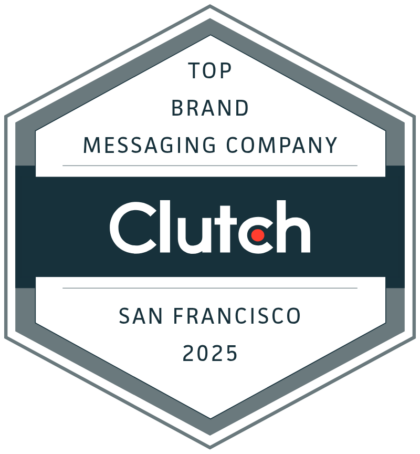Express Your Brand
Every brand has an essence--a center of gravity--that's unique, honest, different and real. Here's how to express that essence in four simple steps.

David Kippen | JANUARY 4, 2016
WHAT DO YOU TALK ABOUT when you talk about brands? Probably a logo and a name. But for most companies, the name and logo are the least interesting parts of their brand. So what should you think about when you think about your brand? How is brand expression done right? How should it connect with corporate strategy? What’s the role of employee and consumer insight in establishing the brand? Where does design come into the mix? And how can your brand make your business better? In this post we’ll take a deeper look at the brand beyond the name. We’ll look at how the brand, the strategy, consumer insight and creative come together when a brand’s working right – and give some examples of what happens when a brand’s lost in the wilderness and needs repositioning. And I’ll give you an overview of what the best brand building process – an evidence-based process –and how it delivers value. (Prefer to listen? You can also check out this blog post on Express, our podcast.)
Let’s start at the beginning, with why we have brands at all. From a marketing standpoint, brands exist to make people take selective action. Brand is a verb in this sense, because I want you to do something when you see it: I want you to take action. Now, that action doesn’t have to happen the moment you see the brand message. In fact, what separates brand advertising and regular advertising is that brand advertising’s goal is to ensure you understand what differentiates your brand from all others, while the goal of advertising is generally to say, “get this product for less during a limited time at this location.”
Think of The Ritz-Carlton and you may think of their iconic lion and crown logo. It’s probably interesting if you care about the brand. But if you know the brand well, you’ll also think of their motto, “ladies and gentlemen serving ladies and gentlemen,” because along with the rest of their Gold Standards, it’s how you experience the brand’s promise. So there’s an important distinction between what the brand looks like and what the brand promises. And as important as they are, the logo and the name aren’t nearly as important as making the right promise clearly and delivering on it consistently.
From a business standpoint brands have an even simpler purpose. All companies focus on brands when they launch because they need a name to incorporate and become an entity and some form of logo to trademark their name. Later, when design elements start to look “dated” or “out of touch,” many do “rebranding” projects. Unfortunately, because they’re focused almost exclusively on design, these usually deliver far less than they should. For example, The Ritz-Carlton’s most recent rebrand focuses almost entirely on minor, forgettable adjustments to the logo’s look and feel. And if they’re not strongly tied to corporate strategy or employee and consumer insights, they can end up hung around the neck of the marketing team as a vanity project. Employees say, “Great. We have a new font and the logo’s a different blue. Wonder how much that cost us?” And they’re right.
So how should business and brand strategy connect? It’s simple in concept. Every good corporate strategy is built around enhancing or defending a specific set of competitive advantages. These are generally things that company does that others don’t do, or don’t do as well. Some of these are secrets. For example, the formula for Coca-Cola is a closely-held secret. Others are obvious: Walmart uses its purchasing power to deliver lower prices. But in most cases, the competitive advantages can – and should – be tied closely to the brand’s promises. The secret Coke formula is how Coca-Cola delivers refreshment; Walmart’s purchasing power and distribution network allow you to “live better” by getting more for your dollar.
That’s pretty straightforward, right? But what if the brand’s corporate strategy changes? What if the marketplace shifts? All too often, corporations respond, but their brands don’t. Walmart’s been flat-footed in responding to Amazon, which successfully attacked both the cost and convenience offerings that had differentiated Walmart. Coke’s been challenged by a change in consumer preference. Ten years of decline in soft drink consumption (mainly toward water) and Pepsi’s taking the #1 crown away in the diet drink category show that even the world’s fourth most valuable brand—and most valuable non-tech brand – isn’t immune to shifts in sentiment.
Sounds easy, right? It’s not. As easy as “defending competitive advantage” is to get your head around, it’s not easy to do. Because doing is the thing and companies – and brands – get all tangled up in the how. Walmart saw Amazon coming for years and did virtually nothing. They couldn’t imagine their target customer shopping online and didn’t get how quickly smartphones, tablets, cheaper computers and a host of other factors would change that. Then when it was almost too late, they spun up Walmart Labs, far away from Bentonville, to counter the threat. Has it worked? Walmart’s 2014 online sales were 12.2 billion versus Amazon’s $89 billion and Amazon’s current market cap of $325 billion is now more than a third greater than Walmart’$197 billon. (Both amounts as of 12/30/15). And here’s a simpler comparison: when did you last choose to shop on walmart.com instead of amazon.com?
And as obvious as the role of the brand is when we think about brands like Coke, Amazon, Walmart and The Ritz-Carlton, it’s even more difficult to get it right when you’re a challenger brand. If you’re jet.com, maybe you fumble through a subscription model, focus on product pages and land on free shipping. For other brands, brands without such a close connection between product and brand, it’s often unclear what role the brand should play. So how do you create a solid, useful brand expression and tie it to strategy? That’s where employee and consumer insight comes in.
Inside Insight
It starts with gathering evidence. At Evviva, we strongly believe that every creative expression is hired to do a job, and to understand the job it has to do starts with careful observation. Every great brand position helps the consumer to understand what the brand uniquely offers. (This is true for B2B brands as well as B2C.) But consumers will only care if the brand meets an important need. So the first step in establishing a brand’s competitive advantage is both listening to and observing the current users of the brand and employees to understand what they value the most highly and what the brand most uniquely offers. It’s important to point out here that we don’t just listen to consumers and we certainly don’t listen just to people who have a need and haven’t “met” the brand. Getting this right requires carefully balancing inputs from the people farthest from the brand (your target customers) those closest to it (the workforce) and several points between to get a balanced, nuanced view of the brand’s strengths, weaknesses and potential for growth and advance.
We listen to hear what they say and to capture what’s unique in how they talk about their brand experience. We observe to see how what they say aligns with what they do—and when it doesn’t, to understand what that difference is trying to tell us. There are a host of ways to listen and observe we’ll talk about later. What’s important here is that the process of listening and watching provides a strong evidence basis for the brand’s “essence,” its unique gift to the world. My colleague Cate Newsom heads up our insight practice. She’s written a brilliant post about building a brand’s evidence base with a step-by-step guide on how to do this. (If you’d prefer to listen, you’ll find her post on episode two of Express.)
Brand & Strategy Playbook
While the essence is important, a strong brand’s much more than a single idea: a well-designed brand offers a system of messages and value, one that’s calibrated to intersect with the customer in different ways at different times and supports corporate strategy. So customer and employee insights are the basis for the brand playbook. This isn’t a design system – that comes later. The playbook takes the brand’s equities, differentiators and key messages and arranges them by audience and sales stage to support the brand’s purchase funnel. This is harder than it sounds, but when it’s done right, the playbook’s an essential compliment to the corporate strategy because it defines the who, what, when, how and why of product/customer fit that inform and shape the brand’s marketing mix.
Why should the purchase funnel and marketing mix factor into your brand? Because if they don’t, your brand and your strategy are completely disconnected. Your brand’s now decoration and your advertising campaigns have twice as much meaning to convey in the same amount of time or space. So the brand’s playbook is one of the most important outcomes of a strong, well executed brand project.
Creative Concepting
With the playbook in hand it’s now time to develop a creative brief and to begin creative expression. The creative brief can take many shapes and forms but all good briefs have two interdependent factors in common. They clearly state the problem the creative must solve. And they’re brief. If the brand is evidence-based, the brief should be, too. A good brief starts with the context and evidence necessary to get the “big idea,” generally followed by a simple question or statement and provides tangible success criteria for the creative (i.e., “we’ll know we’ve got it right when people say…”).
The creative team’s first output is generally a set of creative concepts – words and art that together express the “big idea” in a variety of different ways. What’s important here is that the creative is still evidence-based. (While it’s possible to jump to creative immediately, there’s a far greater risk that the winning creative will be based on what the client likes, rather than what customers care about. That’s obviously risky. And there’s a less obvious risk here, too: it’s possible that the most interesting creative will not align with the brand’s strongest differentiators and equities. When this happens, the brand can easily find itself leaning in the direction of a competitor’s greater strength.)
So how do you get to great creative? Our Director of Creation, Amo Bassan, leads our Edinburgh-based creative team. Edinburgh is where logic meets magic so Amo will post about the creative process and how to get to a great creative outcome later this month.
Creative Selection
The final step is selecting the strongest creative. If it’s evidence-based all the agency’s creative should support the brand’s most important strengths. And if it’s good, each idea will be distinct and unique. Often clients find they have strong positive reactions to a particular direction but even when they do, it’s a good idea to get the customer back into the process and ensure that the creative is telling them what’s important to them in a language and manner that makes sense to them.
There are lots of ways to do this, each with pros and cons. For example, it’s easy and fairly quick to get a large sample response by A/B testing executions (concepts that have been turned into ads) against each other. This works well if you have two concepts you love and can’t decide between them. The biggest drawback of A/B tests is you generally won’t know why the winning concept wins or why the other fails. That can be really important. For example, it might come down to a difference in casting between A and B, which might mean it’s the model, not the idea people are responding to. At the other end of the spectrum, you can get great feedback on every component from qualitative testing – whether it’s street intercepts (asking strangers that match your target persona for feedback), focus groups, or interviews. The challenge here is that people don’t generally spend time studying ads, so the longer they spend talking about what they like and don’t, the more unnatural the experience is. Add examiner bias (whether the respondent likes or dislikes the examiner) and most people’s innate desire to please into the mix and again, it’s clear that you have to take responses with a grain of salt.
From Expression to Impressions
At this point, if you’d followed these steps, you’d have a solid, evidence-based brand concept closely tied to your business strategy and supporting your brand’s most important differentiators. This is when the brand idea moves from expression – “this is who I am” – to impression – “this is how you feel about me.” I’ll pick up here, with brand impression, in February.
Dr. David Kippen serves as Chief Strategist and CEO of Evviva Brands. With a background spanning advertising and communications and a client base spanning the globe and including top brands in every sector, Dr. David Kippen is a world-renowned leader in brand strategy. David’s past clients include Amazon, Ameriprise Financial, Bain & Company, Blackrock, Burger King, Chevron, Coca-Cola, Dell, Dignity Health, Disney, Energy Recovery, E.ON, HP, HSBC, General Mills, Intel, Kaiser Permanente, Kentz, KLA-Tencor, Lam Research, Marriott International, Methanex, Moss Adams, Microsoft, Nokia, Premera Blue Cross, Teva, T-Mobile and Xilinx.
David earned a PhD in English (rhetoric) from the State University of New York at Stony Brook. Prior to founding Evviva Brands he was Head of Global Brand Strategy for TMP Worldwide.
Phone: (415) 320-9777
Email: kippen@evvivabrands.com




















